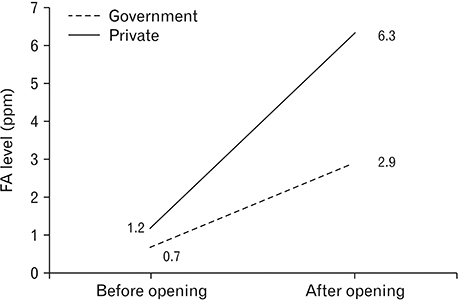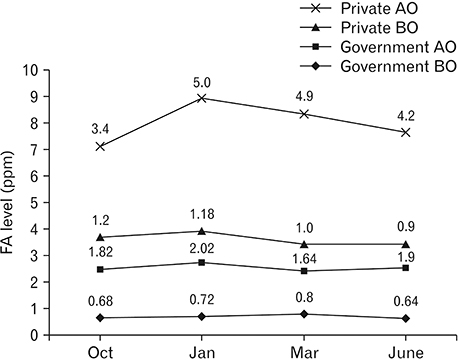Anat Cell Biol.
2019 Dec;52(4):419-425. 10.5115/acb.19.105.
Estimation of occupational formaldehyde exposure in cadaver dissection laboratory and its implications
- Affiliations
-
- 1Department of Anatomy, JSS Medical College, Mysuru, India. deepabhat@jssuni.edu.in
- 2Department of Internal Medicine, JSS Medical College, Mysuru, India.
- 3Department of Community Medicine, JSS Medical College, Mysuru, India.
- KMID: 2466695
- DOI: http://doi.org/10.5115/acb.19.105
Abstract
- The formaldehyde (FA) is a universally used chemical for preservation of cadavers in dissection halls. The adverse effects of formalin exposure are health concern to faculty, workers, and students. The benefits of using formalin, its cost effectiveness, and its proper fixation and efficient preservation of tissue, have to outweigh its adverse effects on the health of those working with it. The best way to ensure the benefits outweigh the risks are providing adequate ventilation, using personal protective equipment, and developing awareness of FA's adverse effects. This study observed that both government and private colleges had better ventilation when more windows and doors were present, but active ventilation strategies like powerful exhaust, along with monitoring of FA level (personal or dissection hall), were needed. Students exposed to FA suffered eye and nose mucosal irritation. But faculty and workers with prolonged exposure to FA had more severe respiratory symptoms and suffered migraines. Hence personal FA monitoring and personal protective equipment must be made mandatory for those with prolonged exposure to FA. In addition, proper ventilation should be in place to reduce formalin vapours levels in workspaces.
Keyword
MeSH Terms
Figure
Reference
-
1. Ghosh SK. Human cadaveric dissection: a historical account from ancient Greece to the modern era. Anat Cell Biol. 2015; 48:153–169.2. Brenner E. Human body preservation: old and new techniques. J Anat. 2014; 224:316–344.3. Coleman R. Reducing the levels of formaldehyde exposure in gross anatomy laboratories. Anat Rec. 1995; 243:531–533.4. Vohra MS. Personal formaldehyde exposure level in the gross anatomy dissecting room at College of Medicine King Saud University Riyadh. Int J Occup Med Environ Health. 2011; 24:108–113.5. Raja DS, Sultana B. Potential health hazards for students exposed to formaldehyde in the gross anatomy laboratory. J Environ Health. 2012; 74:36–40.6. SHA fact sheet [Internet]. Washington, DC: Occupational Safety and Health Administration;2019. cited 2018 Oct 20. Available from: https://www.osha.gov/OshDoc/data_General_Facts/formaldehyde-factsheet.pdf.7. Azari MR, Asadi P, Jafari MJ, Soori H, Hosseini V. Occupational exposure of a medical school staff to formaldehyde in tehran. Tanaffos. 2012; 11:36–41.8. Yamato H, Nakashima T, Kikuta A, Kunugita N, Arashidani K, Nagafuchi Y, Tanaka I. A novel local ventilation system to reduce the levels of formaldehyde exposure during a gross anatomy dissection course and its evaluation using real-time monitoring. J Occup Health. 2005; 47:450–453.9. Saowakon N, Ngernsoungnern P, Watcharavitoon P, Ngernsoungnern A, Kosanlavit R. Formaldehyde exposure in gross anatomy laboratory of Suranaree University of Technology: a comparison of area and personal sampling. Environ Sci Pollut Res Int. 2015; 22:19002–19012.10. Uba G, Pachorek D, Bernstein J, Garabrant DH, Balmes JR, Wright WE, Amar RB. Prospective study of respiratory effects of formaldehyde among healthy and asthmatic medical students. Am J Ind Med. 1989; 15:91–101.11. Wineski LE, English AW. Phenoxyethanol as a nontoxic preservative in the dissection laboratory. Acta Anat (Basel). 1989; 136:155–158.12. Gahukar S, Ramteke U, Majumdar D, Malviya R, Patil D, Trivedi J, Rao C, Kale AH. Prevalence of formaldehyde in indoor air of gross anatomy laboratory and cadaver storage room of a medical college. J Environ Occup Sci. 2014; 3:181–185.13. Shiraishi N. Levels of formaldehyde, phenol and ethanol in dissection room air and measures for reduction. Jpn J Occup Med Traumatol. 2006; 54:1–10.14. Koirala S, Shah S, Khanal L, Pokhrel C, Poudel D. Effect of formalin among the medical and dental students attending regular laboratory session in dissecting hall, in Department of Human Anatomy, in B.P. Koirala Institute of Health Sciences. Eur J Forensic Sci. 2015; 2:1–4.15. Elshaer NS, Mahmoud MA. Toxic effects of formalin-treated cadaver on medical students, staff members, and workers in the Alexandria Faculty of Medicine. Alex J Med. 2017; 53:337–343.16. Gurbuz N, Coskun ZK, Liman FA, Anıl A, Turgut HB. The evaluation of formaldehyde exposure in the anatomy laboratories and the preventive measures. Gazi Med J. 2016; 27:98–103.17. Dimenstein IB. A pragmatic approach to formalin safety in anatomical pathology. Lab Med. 2009; 40:740–746.18. Ya'acob SH, Suis AJ, Awang N, Sahani M. Exposure assessment of formaldehyde and its symptoms among anatomy laboratory workers and medical students. Asian J Appl Sci. 2013; 6:50–55.19. Onyije FM, Avwioro OG. Excruciating effect of formaldehyde exposure to students in gross anatomy dissection laboratory. Int J Occup Environ Med. 2012; 3:92–95.
- Full Text Links
- Actions
-
Cited
- CITED
-
- Close
- Share
- Similar articles
-
- The effect of formaldehyde on neurobehavioral performance of student during cadaver dissection
- The Health Effects of Formaldehyde during an Anatomy Dissection Course
- Implications of Changes in Legal Standards Related to Cadaver Research and Future Tasks
- Current Anatomical Cadaver Dissection and the Limitation of the Act of Corpse Dissection and Preservation
- The Effect of Observation Program of Cadaver Dissection for the Paramedical Students



